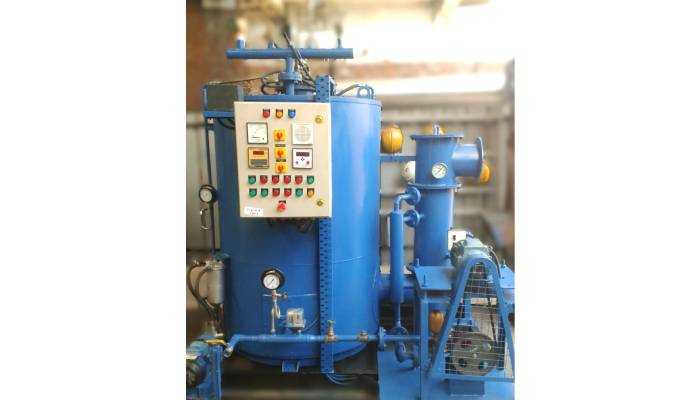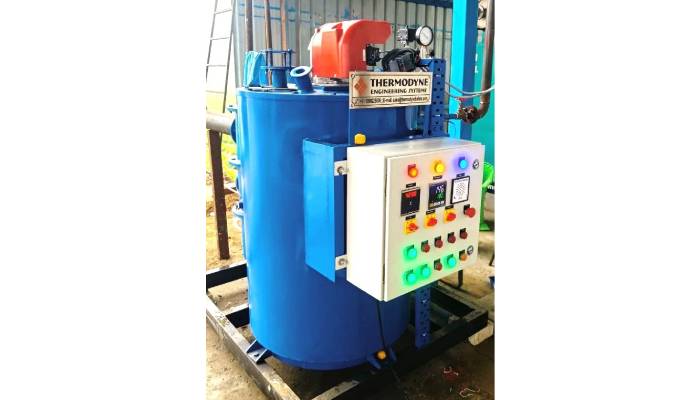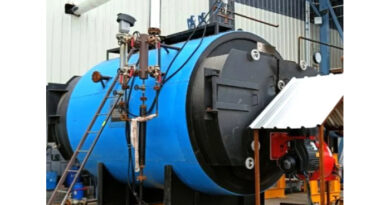Capacity Range: 1000 Kg/hr to 20000 Kg/hr
Fuel Options: Coal, Lignite, Rice Husk, Wood, Bagasse, Groundnut shells, Petcock, and several other Solid fuels.
The Combitherm model features a unique water-cum-smoke tube design, combining the benefits of both water tube and smoke tube boilers. With water tubes enclosing the furnace from five sides, this is the high-temperature zone where efficient radiation heat transfer occurs. The flue gases flow at high velocity through the tubes in the shell, enabling effective convection heat transfer.
The boiler is designed to burn a wide range of fuels like biomass, coal, wood, rice husk, and more, offering full fuel flexibility. Combitherm boilers are available with manual or automatic fuel feeding, depending on fuel type and boiler capacity. Automatic feeding systems, like screw feeders or rotary feeders are typically used for larger boilers, while manual feeding is common for smaller setups.
Combitherm Boiler working:
Water is fed to the boiler from a feed pipe connection. Firstly, the water fills in the shell and then gets transported to the Bottom Header of the water wall from the Down-comers welded to the Boiler Shell.
From here the water rises up in the tubes of the water wall and gets thrown back to the boiler shell from the top header. As firing is done in the furnace, because of radiation the surface temperature of the water wall membrane rises and the water present in the tubes gets heated up and starts getting converted to steam.
Now this steam, being less dense (creating a natural circulation of steam-water in the system), rises up to the top header and gets to the Boiler Shell. The flue gas from the furnace (1st pass), traveling in the membrane, then enters the tube of Boiler Shell. In Boiler Shell flue gasses flow in the tube.
These Boiler Tubes are divided in 2 passes (2nd pass & 3rd Pass) where flow gas travel from both the passes and transfer heat to water through convective heat transfer. Steam coming from both the sides gets collected at the top of the Boiler shell and then supplied through steam lines for the desired process application.
3 Pass Smoke Cum Water Tube Boiler design can burn a variety of fuels like Coal, Rice Husk, Wood, Bagasse, Groundnut shells, and several other fuels thus providing you with lowest energy costs depending upon the fuel available in your area.
The large furnace grate area and furnace volume in case of Combitherm Boilers provide optimum time for fuel to get burnt. On the basis of fuel firing our Combitherm boilers can be divided into 2 types:

- Manual firing boiler.
- Automatic firing boiler.
When fuel feeding to the boiler is done manually generally in case of small capacity boilers where the amount of fuel fed to the boiler is generally less is said to be manual firing boiler and when fuel feeding is done automatically usually with the help of screw feeder, drum feeder, chain grate, pulsating grate etc. are said to be automatic firing boiler. Manual and automatic firing also depends upon the type of fuel.
Thermodyne has a vast experience in manufacturing Combi boilers that can burn almost all types of fuels.
Advantages:
- The flexibility of fuels with choice of agricultural waste fuels.
- Combines the advantage of both water tube and smoke tube designs.
- High thermal efficiency and low operating costs.
- Minimum site work, low installation costs.
- The higher degree of Equipment’s Reliability.
- Dependable quality of components like valves, pumps, safeties & instruments.
- Can be converted to liquid/gaseous fuels as well.
- Heat recovery units may be offered for enhanced efficiency.
- Easy access for cleaning and inspection.
Three Pass Smoke Cum Water Tube Type Boiler
A three-pass smoke cum water tube type boiler is a type of boiler that uses the heat from the combustion gases to heat water in three passes. The first pass is through the smoke tubes, the second pass is through the water tubes, and the third pass is through the economizer. This type of boiler is very efficient, as it uses the heat from the combustion gases to the fullest extent.
Working Of 3 Pass Boiler Working
A three-pass boiler is a type of steam boiler used for generating heat or steam in industrial processes. It’s designed to increase efficiency by maximizing the transfer of heat from the combustion gases to the boiler water. Here’s how it works:
First Pass: Combustion Gases
- Combustion Chamber: The process begins in the combustion chamber where fuel, often in the form of natural gas, oil, or coal, is burned to produce hot gases and flames.
- Flue Gas Flow: The hot combustion gases and smoke rise upward through the first pass of the boiler, heating the walls of the combustion chamber.
- Heat Transfer: Heat is transferred from the hot gases to the water-cooled walls of the combustion chamber. As a result, the temperature of the gases decreases, and they begin to lose heat energy.
Second Pass: Heat Transfer
- Transition to Second Pass: The partially cooled gases then flow downward or transition through a series of tubes or passages to enter the second pass of the boiler.
- Heat Exchange: In the second pass, the hot gases continue to transfer heat to the tubes or passages. These tubes are surrounded by water, and the heat from the gases causes the water within the tubes to heat up and turn into steam.
- Temperature Drop: As the heat is transferred, the temperature of the combustion gases further reduces, and the steam inside the tubes becomes hotter.
Third Pass: Final Heat Transfer
- Transition to Third Pass: The now cooler gases transition to the third pass, often moving through additional sets of tubes or passages before being released into the flue.
- Final Heat Exchange: In this final pass, any remaining heat is extracted from the gases, ensuring that as much heat as possible is transferred to the water for steam generation.
- Exhaust: After completing the third pass, the gases are considerably cooler and are released into the chimney or exhaust stack. These gases are now less energetic and have transferred a significant portion of their heat energy to the boiler water.
Benefits of Three-Pass Boilers:
The three-pass design offers several advantages:
- Enhanced Heat Transfer: The multi-pass design allows for more thorough heat transfer, increasing efficiency and reducing fuel consumption.
- Lower Emissions: Efficient combustion and heat transfer result in fewer unburned particles and reduced emissions.
- Increased Safety: The multiple passes and tubes provide a larger surface area for heat exchange, preventing overheating and potential boiler damage.




